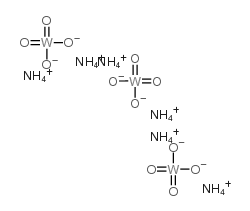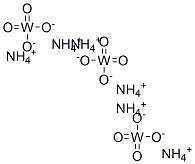钨酸铵水合物, ,Ammonium metatungstate hydrate
产品编号:西域试剂-WR363063| CAS NO:12028-48-7| MDL NO:MFCD00042673| 分子式:(NH4)6W12O39·xH2O| 分子量:2938.41(anhy)
本网站销售的所有产品仅用于工业应用或者科学研究等非医疗目的,不可用于人类或动物的临床诊断或者治疗,非药用,非食用,
| 英文名称 | Ammonium metatungstate hydrate |
|---|---|
| CAS编号 | 12028-48-7 |
| 产品熔点 | 100ºC (dec.)(lit.) |
| 精确质量 | 851.99800 |
| PSA | 240.78000 |
| LogP | 0.83160 |
| 外观性状 | Powder | white |
| 溶解性 | H2O: 0.1 g/mL, clear, colorless | Soluble in water. Insoluble in alcohol. |
| 稳定性 | 常温常压下稳定 避免光,明火,高温。易溶于水,不溶于醇,水溶液呈弱酸性。 |
| 储存条件 | 常温密闭,阴凉通风干燥处 |
相关文档
化学品安全说明书(MSDS)
下载MSDS质检证书(COA)
相关产品
| 危害码 (欧洲) | Xn: Harmful; |
|---|---|
| 风险声明 (欧洲) | 22-41-52/53 |
| 安全声明 (欧洲) | 26-39-60 |
| WGK德国 | 2 |
|
Section 1. Chemical Product and Company Identification Ammonium metatungstate Common Name/ Trade Name Ammonium metatungstate Section 4. First Aid Measures Eye ContactCheck for and remove any contact lenses. In case of contact, immediately flush eyes with plenty of water for at
least 15 minutes. Cold water may be used. Get medical attention if irritation occurs. Skin ContactWash with soap and water. Cover the irritated skin with an emollient. Get medical attention if irritation develops. Cold water may be used. Serious Skin ContactNot available. InhalationIf inhaled, remove to fresh air. If not breathing, give artificial respiration. If breathing is difficult, give oxygen. Get medical attention. Serious InhalationNot available. IngestionDo NOT induce vomiting unless directed to do so by medical personnel. Never give anything by mouth to an unconscious person. If large quantities of this material are swallowed, call a physician immediately. Loosen tight clothing such as a collar, tie, belt or waistband. Serious IngestionNot available. Section 5. Fire and Explosion Data Flammability of the Product Non-flammable. Auto-Ignition Temperature Not applicable. Flash PointsNot applicable. Flammable LimitsNot applicable. Not available. Products of Combustion Fire Hazards in Presence of Not applicable. Various Substances Explosion Hazards in Presence Risks of explosion of the product in presence of mechanical impact: Not available. of Various SubstancesRisks of explosion of the product in presence of static discharge: Not available. Fire Fighting MediaNot applicable. and Instructions Special Remarks onNot available. Fire Hazards Special Remarks on Explosion Not available. Hazards Section 6. Accidental Release Measures Small SpillUse appropriate tools to put the spilled solid in a convenient waste disposal container. Finish cleaning by spreading water on the contaminated surface and dispose of according to local and regional authority requirements. Large Spill Isolate spill area and provide ventilation. Vacuum up spill using a HEPA air filter or use a shovel to pick up the spilled material and place material in a closed container for proper disposal. Take care not to raise dust. Finish cleaning by spreading water on the contaminated surface and allow to evacuate through the sanitary system. Be careful that the product is not present at a concentration level above TLV. Check TLV on the MSDS and with local authorities. Ammonium metatungstate Section 7. Handling and Storage PrecautionsDo not breathe dust. Keep away from incompatibles such as oxidizing agents, alkalis. StorageKeep container tightly closed. Keep container in a cool, well-ventilated area. Section 8. Exposure Controls/Personal Protection Engineering ControlsUse process enclosures, local exhaust ventilation, or other engineering controls to keep airborne levels below recommended exposure limits. If user operations generate dust, fume or mist, use ventilation to keep exposure to airborne contaminants below the exposure limit. Personal ProtectionSafety glasses. Lab coat. Dust respirator. Be sure to use an approved/certified respirator or equivalent. Gloves. Personal Protection in Case of Splash goggles. Full suit. Dust respirator. Boots. Gloves. A self contained breathing apparatus should be used a Large Spillto avoid inhalation of the product. Suggested protective clothing might not be sufficient; consult a specialist BEFORE handling this product. TWA: 5 (mg/m3) from OSHA (PEL) [United States] Exposure Limits TWA: 1 (mg/m3) from ACGIH (TLV) [United States] Consult local authorities for acceptable exposure limits. Section 9. Physical and Chemical Properties Physical state and appearance Solid. (Crystalline powder. Powdered solid.)OdorOdorless. TasteNot available. Molecular Weight2938.41 g/mole ColorWhite. pH (1% soln/water)Not available. Not available. Boiling Point Melting PointNot available. Not available. Critical Temperature Specific Gravity4 (Water = 1) Vapor PressureNot applicable. Vapor DensityNot available. VolatilityNot available. Not available. Odor Threshold Water/Oil Dist. Coeff.Not available. Ionicity (in Water)Not available. Dispersion PropertiesSee solubility in water. SolubilityPartially soluble in cold water. Insoluble in methanol, n-octanol. Section 10. Stability and Reactivity Data StabilityThe product is stable. Not available. Instability Temperature Conditions of InstabilityIncompatible materials, dust generation Incompatibility with variousReactive with oxidizing agents, alkalis. substances CorrosivityNon-corrosive in presence of glass. Ammonium metatungstate Special Remarks onAlso incompatible with halogens. ReactivityStrong bases may release ammonia gas Special Remarks onNot available. Corrosivity PolymerizationWill not occur. Section 11. Toxicological Information Routes of EntryInhalation. Ingestion. Toxicity to AnimalsLD50: Not available. LC50: Not available. Chronic Effects on Humans May cause damage to the following organs: kidneys. Other Toxic Effects onHazardous in case of ingestion. HumansSlightly hazardous in case of skin contact (irritant), of inhalation. Special Remarks on Not available. Toxicity to Animals Special Remarks onNot available. Chronic Effects on Humans Special Remarks on otherAcute Potential Health Effects: Toxic Effects on HumansSkin: May cause mild irritation of the skin with redness, and itching. Eyes: May cause mild irritation of the eyes with redness, itching, watering. Inhalation: May cause irritation to th enose, mucous membranes and respiratory tract with sneezing, dry throat, and coughing. Ingestion: Tungstate compounds may cause changes in body weight and behavior. Chronic Potential Health Effects: Skin: Prolonged or repeated contact may cause dermatitis. Ingestion: Prolonged or repeated ingestion of large doses may cause kidney damage Section 12. Ecological Information EcotoxicityNot available. BOD5 and CODNot available. Products of BiodegradationPossibly hazardous short term degradation products are not likely. However, long term degradation products may arise. Toxicity of the ProductsThe products of degradation are as toxic as the original product. of Biodegradation Not available. Special Remarks on the Products of Biodegradation Section 13. Disposal Considerations Waste DisposalWaste must be disposed of in accordance with federal, state and local environmental control regulations. Ammonium metatungstate Section 14. Transport Information DOT ClassificationNot a DOT controlled material (United States). IdentificationNot applicable. Not applicable. Special Provisions for Transport DOT (Pictograms) Section 15. Other Regulatory Information and Pictograms TSCA 8(b) inventory: Ammonium metatungstate Federal and State Regulations CaliforniaCalifornia prop. 65: This product contains the following ingredients for which the State of California has found to cause cancer which would require a warning under the statute: No products were found. Proposition 65 Warnings California prop. 65: This product contains the following ingredients for which the State of California has found to cause birth defects which would require a warning under the statute: No products were found. Other RegulationsOSHA: Hazardous by definition of Hazard Communication Standard (29 CFR 1910.1200). EINECS: This product is on the European Inventory of Existing Commercial Chemical Substances. WHMIS (Canada) Not controlled under WHMIS (Canada). Other Classifications DSCL (EEC)This product is not classified according Not applicable. to the EU regulations. Health Hazard HMIS (U.S.A.)2 National Fire Protection 0 Flammability 0 Association (U.S.A.) Fire Hazard 2 0 Reactivity Health Reactivity 0 Specific hazard Personal Protection E WHMIS (Canada) (Pictograms) DSCL (Europe) (Pictograms) TDG (Canada) (Pictograms) ADR (Europe) (Pictograms) Ammonium metatungstate Protective Equipment Gloves. Lab coat. Dust respirator. Be sure to use an approved/certified respirator or equivalent. SECTION 16 - ADDITIONAL INFORMATION N/A |








 浙公网安备 33010802013016号
浙公网安备 33010802013016号